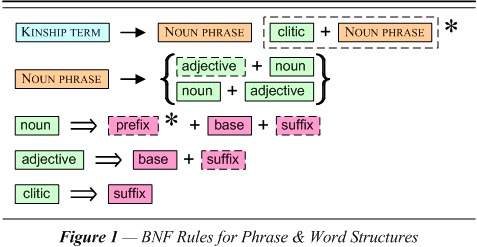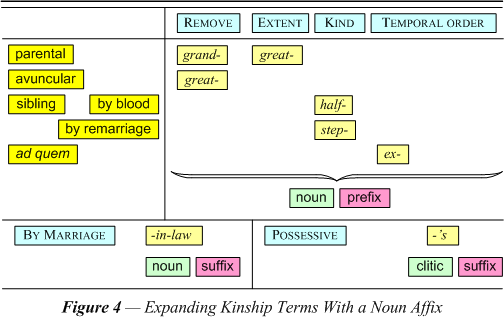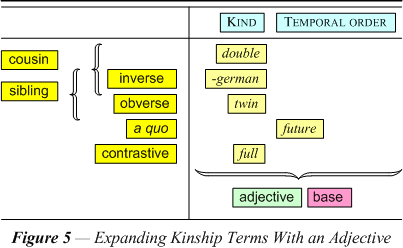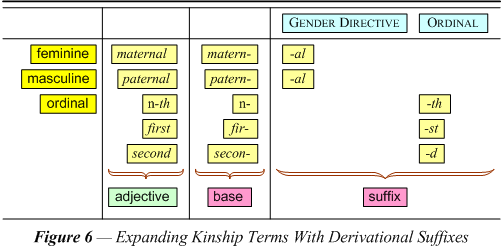
Linguistic models. It was demonstrated above that various kinship chains are named in a number of ways. The British culture constrains its people to view certain kinship chains as being more important than others. Their English language has its own way of applying its set of terms to certain chains. In general English structures kinship terms with other noun phrases. The various possibilities are laid out in figure 1:

The first rule allows the term to be as long as needed to express the meaning of a kinship chain of any length. This is done by means of the clitic known in grammar as the possessive case, which attaches itself to the last word of the noun phrase. Figure 2 gives elements that would belong to such a long term: former wife’s third husband’s paternal great-great-granduncle’s step-son.

However unusual, such chains may be given a term. The words are classed as nouns or adjectives, which sometimes precede and sometimes follow the noun. Normally we can analyze the words as composed of parts (morphemes) that may carry the most elemental of the meanings. English morphology has prefixes and suffixes that attach to a base. Note that the prefix great- can be attached to a base even when it has already got a prefix attached.
Terms consisting of a noun base. There are seventeen single word terms that refer to some of the shortest kinship chains. Five of them are unspecified with respect to the sex of the individual being referred to, but the other twelve are either masculine or feminine. It is of some interest that five of the terms end in -er. This word part was probably at some early stage of the language a morpheme related to the -er that forms agent nouns in English today. There are two categories that have no gender-neutral term to oppose their two gender-specific terms. I have made up some new words from Latin to refer to these categories: neptic and avuncular.

Expanding terms with a noun affix. One fruitful way of expanding on the seventeen simplest kinship terms is to add a prefix and/or a suffix to it. The prefix great- has the meaning of grand- when used alone with uncle or aunt, though, here the prefix grand- is sometimes heard. The prefix ex- is almost exclusively used with the spouse terms, but conceivably might also occur with a step-sibling when the family is disolved by divorce.

There are many situations when the term may be expanded by simply adding the suffix -in-law. This term then refers to the corresponding relative of the spouse. There is also a suffix that effects the syntax of the terms — the so-called possessive. This ending was originally an inflectional case of the noun, but has long been analyzed as effecting the meaning of the noun phrase. Notice that in the phrase “the queen of England’s crown” the possession is by the queen, not England, to which word the -s is attached. The point can be made that this phrase is really a proper noun (compounded), but other examples could be cited: the woman in trouble’s predicament; the man on the next corner’s news stand. Linguists usually call a morpheme that marks the syntax in this way a clitic.
Expanding terms with an adjective. A common way to expand meaning of the noun is by the use of one of the limiting adjectives of figure 5. One way is to simply add the bare adjective in front of (obverse order), but sometimes following (inverse order) the noun. The adjective german can appear with either a sibling term as in a brother german, i.e., a full brother, or as in cousin-german. Some people like to hyphenate this word, probably because of the unusual nature of its limiting function even though it stands behind the noun.

The noun twin may be used attributively as an adjective to designate a sibling who shares one’s birth event. A person who has a pair of twins for siblings, however, would not refer to one of them as his twin brother or her twin sister. Only the twin could be the ego for this term. In the rare case of other multiple births, such as triplets, quadruplets, etc., it is conceivable that the person so related might use such a term (ambiguously) to refer to “my triplet sister.”
Expanding terms with adjective forms. The adjective used to expand the simple kinship term may be derived and thus analyzable into two separate morpheme parts. One such set of modifiers sets apart relatives on the father’s lineage from those on the mother’s. I have called these adjectives gender directives. The other such set of modifiers is used in various places for their indexical function — the ordinal numbers. An ordinal may give the number of great- prefixes the equivalent term would require, so that we use, third great-grandmother instead of great-great-great-grandmother, for example. It may give the sequence of the spouse or child in a family, as in my first wife and my fourth son. This use may interfere with the other so that a third great-granddaughter would need more context to interpret. She is either a great-great-great-granddaughter or next after the second oldest of the great-granddaughters. The first few ordinals are irregular (suppletive), but most are formed by adding the suffix -th to the corresponding cardinal number form.

The adjective that modifies the kinship term may also be in its comparative or superlative form. The suppletive form for the ordinal of one (1), i.e., first, is the superlative form of the adverb “fore,” meaning “foremost.” The superlative in next and last are also rather hidden, being formed from the adverbs “nigh” and “late,” whose comparatives are “near” and “latter,” respectively. Former in the sense of “preceding” is often used to refer to the spouse in a family just previous, one which no longer exists.

